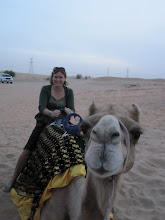 Self-take in Durbur Square, Kathmandu.
Self-take in Durbur Square, Kathmandu.All I can say is, I Love Nepal! Our weekend in Nepal was absolutely amazing, and probably one of the best vacations we have been on in a long time. I think I enjoyed it so much because it was so unlike anywhere else I have ever been, and I learned so much about a culture that I knew very little about. I have never been anywhere so 3rd World before, so that was truly a new experience for me. I thought the UAE was a 3rd World country, but now, for the first time in my life, I can say with certainty that I can distinctly picture the vast differences between a 2nd World country (the UAE) and a definitively 3rd World country (Nepal). The roads are all basically very pot-holed dirt, with people walking barefoot and monkeys and cows randomly wandering around everywhere. There are also rolling blackouts throughout the city, as the power grid can't handle the volume of electricity necessitated to keep the city of Kathmandu (the capital of Nepal) running. So in sections of the city, the electricity can be off for up to 16 hours a day. Definitely weird and slightly scary. So, as a result of the 3rd world nature of the country (and cheap cost!) we decided to stay at the 5-Star Hyatt Regency Hotel. If we were going to be 'roughing it' so to speak while touring around, we at least wanted to make sure we had a decent place to go back to at night.
 Our room at the Hyatt Regency. Actually really nice, and better than just decent. There was a flashlight on the night stand though, which we actually did need when the power went off twice (fortunately, our hotel had a generator, the perk of staying at a 5-Star).
Our room at the Hyatt Regency. Actually really nice, and better than just decent. There was a flashlight on the night stand though, which we actually did need when the power went off twice (fortunately, our hotel had a generator, the perk of staying at a 5-Star). The view from our hotel room, within the gated Hyatt complex, complete with machine-gun toting gate guards.
The view from our hotel room, within the gated Hyatt complex, complete with machine-gun toting gate guards.One of the most appealing parts of planning our Nepal getaway was the cost. It was so darn cheap! Literally cheaper to fly 4-hours away than it was to drive an hour to Abu Dhabi for a couple nights. When we were researching how to get around Kathmandu we were reading about the various taxi options. If you wanted to catch a taxi at the taxi stand, you would end up paying about $1 USD for your ride into the city center. But, if you wanted to spring for the swankier "pre-pay" taxi, it would cost a whopping $6 USD to get to the city center. Well, being the big-spenders, we decided to spring for the pre-pay, which as it turned out was a 1985 Toyota Corolla low-rider with a rusty screw for a lock handle on my side, and the driver asked if we wanted "air conditioning" when we got in and then pointed to the window cranks. Quite the fancy ride.
Once we got to the hotel, after checking in (and getting convinced to upgrade to Club Level... hey, it was only an extra $40 a night for free breakfast and Happy Hours with booze), we dropped off our stuff and then got a little snack in the club lounge to make our action plan. We decided we would explore Kathmandu for the first day and then talk to the Hotel Concierge and book a car and guide for our second day to get a tour of the Kathmandu Valley (once again, much too cheap to pass up: 8 hours in a private car with guide for $120, we couldn't believe the bargain). So another $5 taxi ride from the hotel (through the tiny streets in a ramshackle car, narrowly avoiding pedestrians and cows on every turn) and we were dropped off in Durbur Square in Kathmandu. "Durbur" means Palace, so apparently there is a Durbur Square in every village, where the ruling family of the village lived.
 The Square is beautiful and loaded with pagoda-style Hindu temples. It was fun to just wander around, but you can't stand still for too long without getting accosted by Nepali-men of all shapes and sizes offering to be your tour guide. Some were so aggressive we had to keep moving to ward them off.
The Square is beautiful and loaded with pagoda-style Hindu temples. It was fun to just wander around, but you can't stand still for too long without getting accosted by Nepali-men of all shapes and sizes offering to be your tour guide. Some were so aggressive we had to keep moving to ward them off. Another view of Durbur Square.
Another view of Durbur Square.
















































